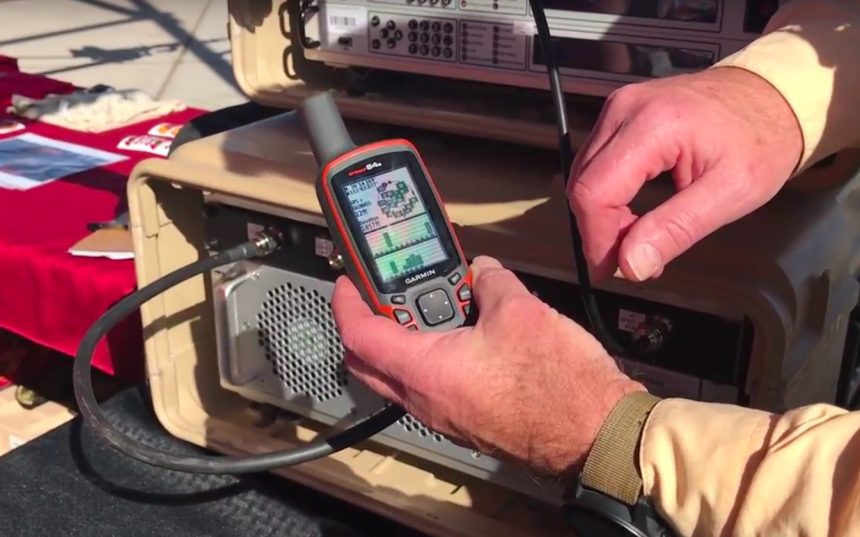GPS Jamming is a New Story from Red Flag 18-1, But We Videotaped It at Nellis Last Year.
Despite the Jan. 27, 2018 accident with a Royal Australian Air Force EA-18G Growler, the massive tactical air training exercise Red Flag 18-1 continues from Nellis AFB outside Las Vegas, Nevada. The training exercise extends throughout the sprawling 7,700 square mile Nellis Military Operating Area (MOA) ranges.
Aviation authority and journalist Tyler Rogoway broke the story of the U.S. Air Force jamming GPS signals on a large scale for training purposes during Red Flag 18-1 in an article for The War Zone last week. But earlier in 2017 we went inside Nellis AFB to get a firsthand demonstration of how easy and how quickly the U.S. Air Force can jam GPS signals for training purposes.
In our demonstration, members of the 527th Space Aggressor Squadron (527th SAS) at Nellis AFB showed us how they can use off-the-shelf equipment to conduct tactical short-range jamming of the GPS signal on a local level. The 527th Space Aggressor Squadron was at Nellis AFB for the 2017 Aviation Nation Air and Space Expo. Our reporters got a firsthand look at GPS jamming on media day. In only a few seconds members of the 527th SAS used off-the-shelf equipment available to the public to jam local GPS reception. As you can see in the video, the signal bars on our test receiver, a typical consumer GPS, disappeared entirely as thought GPS simply didn’t exist anymore.
The 527th Space Aggressor Squadron’s mission is not active combat jamming of GPS, but to provide these and other electronic warfare capabilities for training purposes in exercises like Red Flag 18-1. The unit is based at Schriever AFB in Colorado but is attached to the 57th Wing at Nellis. According to the U.S. Air Force, the 57th Wing, “is the most diverse wing in the Air Force and provides advanced, realistic and multi-domain training focused on ensuring dominance through air, space and cyberspace.”
The 527th Space Aggressor Squadron personnel showed enthusiasm for their mission and reminded us that cyber and electronic warfare is the most dynamic and fastest growing battlespace in modern combat.

In an operational environment jamming GPS signals represents both a threat and an important capability. In addition to serving an important purpose in navigation on land, sea and in the air GPS also provides targeting capability for precision weapons along with many other tactical and strategic purposes.
For instance, among the various theories surrouding the capture of the U.S. RQ-170 Sentinel drone by Iran in 2011, one mentioned a GPS hack. This is what The Aviationist’s David Cenciotti wrote back then:
Eventually there is an explanation for the mysterious capture of the U.S. stealth drone by Iran. In an exclusive interview to the Christian Science Monitor, an Iranian engineer (on condition of anonymity) working to reverse engineer the RQ-170 Sentinel hacked while it was flying over the northeastern Iranian city of Kashmar, some 225 kilometers (140 miles) away from the Afghan border, says they were able to exploit a known vulnerability of the GPS.
In simple words, in a scenario that I had more or less described in my last post which described also the known threats to the drone’s Position, Navigation and Guidance system, the Iranain electronic warfare specialist disrupted the satellite link of the American robot and then reconfigured the drone’s GPS setting the coordinates to make it land in Iran at what the Sentinel thought it was its home base in Afghanistan.
They jammed the SATCOM link and then forced the drone into autopilot reconfiguring the waypoint of the lost-link procedure to make it land where they wanted.
Such techniques were tuned by studying previously downed smaller drone, like the 4 U.S. and 3 Israeli that could be exhibited in Iran in the next future.
Although we don’t know what really happened to the Sentinel drone during its clandestine mission (in the above article our own Cenciotti was skeptical about the version mentioned by the anonymous Iranian engineer), it’s pretty obvious that dominating the GPS “domain” is crucial to win. That’s why during Red Flag 18-1 the widespread jamming of GPS for training purposes enables warfighters to operate in an environment where electronic and cyber-attacks may disable GPS capability. This compels the players to develop new tactics for fighting “GPS blind” and to revisit existing capabilities perfected in the era prior to widespread use of GPS in a warfighting role.










